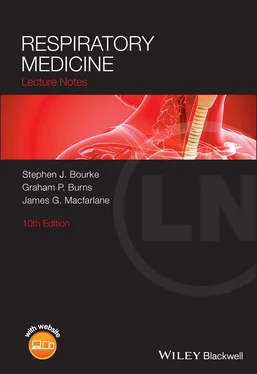2 Look at the PCO 2 . Ask whether the PCO2 is contributing to or attempting to compensate for the abnormality identified in the pH. That will allow you to know whether the primary disturbance is respiratory (contributing) or metabolic (attempting to compensate).
3 Look at the bicarbonate. I would suggest either the sHCO3 – or base excess. In the case of a primary metabolic problem, the bicarbonate may hold no surprises. In a metabolic acidosis, it will be low; in a metabolic alkalosis, high. In the case of a primary respiratory problem, the bicarbonate may be normal (suggesting the problem is acute, having not had time to change), attempting to correct the respiratory effect on the pH (suggesting the problem is chronic) or compounding the problem (suggesting a mixed disturbance).
4 Look at the PO 2 .Knowing the inspired partial pressure of oxygen, ask whether the PO2 is what you’d expect given the level of ventilation (i.e. given the PCO2) or lower than expected. This may be difficult to gauge, in which case the alveolar gas equation should be applied (see Chapter 1). You can then determine whether type I respiratory failure, type II respiratory failure or both are present.
 KEY POINTS
KEY POINTS
A reduced FEVI:VC ratio indicates airways obstruction (e.g. asthma, COPD).
A reduced KCO indicates disease of the lung parenchyma or its blood supply (e.g. emphysema, lung fibrosis, pulmonary embolism).
Type I respiratory failure is hypoxia without hypercapnia and may occur in any disease intrinsic to the lung (e.g. asthma, pulmonary oedema, pulmonary embolism, lung fibrosis).
Type II respiratory failure is hypoxia with hypercapnia and indicates hypoventilation (e.g. sedative overdose, neuromuscular disease or moderate to severe COPD where it occurs in conjunction with a type I respiratory failure).
An elevated alveolar–arterial gradient implies a problem intrinsic to the lung.
 FURTHER READING
FURTHER READING
1 Burns GP. Arterial blood gases made easy. Clin Med 2014; 14: 66–8.
2 Maynard RL, Pearce SJ, Nemery B, Wagner PD, Cooper BG. Cotes’ Lung Function. Oxford: Wiley Blackwell, 2020.
3 Flenley DC. Interpretation of blood‐gas and acid–base data. Br J Hosp Med 1978; 20: 384–94.
4 Gibson GJ. Clinical Tests of Respiratory Function. Oxford: Oxford University Press, 2009.
5 Gibson GJ. Measurement of respiratory muscle strength. Respir Med 1995; 89: 529–35.
6 Hanning CD, Alexander‐Williams JM. Pulse oximetry: a practical review. BMJ 1995; 311: 367–70.
Multiple choice questions
1 3.1 The volume of gas in the lungs after a full expiration is: residual volumetotal lung capacity minus residual volumefunctional residual capacitytidal volume plus functional residual capacityvital capacity minus residual volume
2 3.2 Lung function test results of: FEV 1 reduced, FEV 1 :VC normal, KCO reduced would be most in keeping with: kyphoscoliosisidiopathic pulmonary fibrosispulmonary hypertensionasthmaCOPD
3 3.3 Arterial blood gases of pH 7.32, PCO 2 8.0 kPa, PO 2 13.0 kPa, sHCO 3 28 mmol/L, O 2 saturation 97% are most in keeping with: a chronic metabolic acidosisan acute on chronic metabolic acidosisan overcompensated metabolic alkalosisan acute on chronic respiratory acidosisa chronic respiratory acidosis
4 3.4 Given arterial blood gases of pH 7.32, PCO 2 8.0 kPa, PO 2 13.0 kPa, sHCO 3 28 mmol/L, O 2 saturation 97%, one could confidently conclude that: the patient is breathing supplemental oxygenthe patient has COPDthe patient needs to be transferred to ITUthe condition is chronic and stablethe lungs are normal
5 3.5 A 24‐year‐old woman presents to hospital as an emergency with breathlessness. Her arterial blood gases while breathing room air are pH 7.49, PCO 2 2.9 kPa, PO 2 12.5 kPa, sHCO 3 24 mmol/L, O 2 saturation 97%. This presentation is most in keeping with: pulmonary embolismanxietyopiate overdoseexcess vomitingpneumonia
6 3.6 A 46‐year‐old man has an FEV 1 that is only 80% of the predicted value: his exercise capacity will be approximately 80% of age/height‐matched peershe will be 20% more breathless than age/height‐matched peershe has airway obstructionthis is consistent with the absence of any lung disease at allit is likely that he smoked
7 3.7 A reduced forced vital capacity (FVC): always accompanies a reduction in FEV1can be seen in muscular weakness even when the lungs are normalcannot be present if slow (relaxed) vital capacity is normalsuggests lung fibrosisis a bad prognostic marker
8 3.8 In diseases causing weakness of the respiratory muscles, the pattern of lung function disturbance expected would be: reduced FEV1, relatively normal FVCnormal FEV1:FVC ratio, reduced KCOreduced FEV1 and FVC, increased KCOnormal lung functionincreased FEV1:FVC ratio
9 3.9 Transfer coefficient (KCO) would be reduced in the following conditions: obesityCOPDpulmonary haemorrhageasthmathyrotoxicosis
10 3.10 In muscular dystrophy affecting the respiratory muscles, the following physiological findings would be expected: reduced FEV1reduced FVCreduced TLCOreduced KCOreduced TLC
1 3.1 ASee Fig. 3.1.
2 3.2 BThe normal FEV:VC and reduced FEV1 imply restriction. The reduced KCO suggests the cause is intrapulmonary.
3 3.3 DThe pH is low, so this is an acidosis. The PCO2 is high, so this is a respiratory acidosis. The bicarbonate is high, suggesting there has been time to attempt to compensate (chronic). However, the pH would be in the normal range had this been a chronic stable state, so there must be an acute component. Remember, too, that physiological compensatory mechanisms don’t overcompensate.
4 3.4 AIf you assume the patient is breathing room air (PIO2 = 21 kPa), then the alveolar–arterial gradient (see Chapter 1) will be negative (partial pressure of oxygen higher in the arterial blood than in the alveoli), suggesting the patient is a net contributor of oxygen to the environment. This seems unlikely. The inspired PO2 therefore must be greater than 21 kPa.The condition is clearly not stable; the pH is outside the normal range. As we aren’t given the PIO2, we can’t conclude the lungs are normal. The A–a gradient may be very high.
5 3.5 AThis is a primary respiratory alkalosis, so the answer must be either anxiety‐driven hyperventilation or pulmonary embolism. The alveolar arterial gradient is increased, implying a problem within the lungs (affecting V/Q matching), which anxiety cannot explain.
6 3.6 DAt 80% of the predicted value, the result is still well within the normal range and therefore can be found within the normal population (of course, this doesn’t mean you can conclude that there is no disease present).
7 3.7 BMuscular weakness can inhibit the ability to fill the lungs to their capacity, therefore when the FVC manoeuvre is performed there’s less than the normal amount of air to be expelled. Although a reduced FVC may be seen in lung fibrosis, it is seen in many other conditions and therefore cannot be taken to ‘suggest’ fibrosis in isolation.
8 3.8 CMuscle weakness is an example of an extrapulmonary restrictive defect. Therefore, FEV1 and FVC will be reduced (approximately in proportion) and the gas transfer per unit lung volume (KCO) will be elevated (see text).
9 3.9 BIn pulmonary haemorrhage, obesity and asthma, KCO is typically elevated (see text). Thyrotoxicosis is a high cardiac output condition with more than the average amount of blood in the pulmonary circulation. There is therefore increased capacity to absorb CO (KCO may therefore be high).
Читать дальше

 KEY POINTS
KEY POINTS FURTHER READING
FURTHER READING









